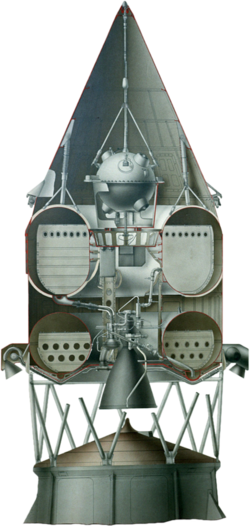Engineering:Luna (rocket)
 Blok E upper stage, with Luna payload | |
| Function | Carrier rocket |
|---|---|
| Manufacturer | RKK Energia |
| Country of origin | Soviet Union |
| Size | |
| Mass | 277,000 kg (611,000 lb) |
| Stages | 3 |
| Capacity | |
| Payload to LEO | 4,000 kilograms (8,800 lb) |
| Associated rockets | |
| Family | R-7 |
| Launch history | |
| Status | Retired |
| Launch sites | Baikonur: LC-1/5 |
| Total launches | 9 |
| Successes | 3 |
| Notable payloads | Luna probes |
| First stage (Block B, V, G, D) | |
| Engines | 1 RD-107-8D74-1958 |
| Thrust | 990.00 kN |
| Burn time | 120 seconds |
| Fuel | Kerosene/LOX |
| Second stage (Block A) | |
| Engines | 1 RD-108-8D75-1958 |
| Thrust | 936.500 kN |
| Burn time | 320 seconds |
| Fuel | RP-1/LOX |
| Third stage (Block E) | |
| Engines | 1 RD-0105 |
| Thrust | 49.0 kN |
| Burn time | 316 seconds |
| Fuel | Kerosene/LOX |
The Luna 8K72 vehicles were carrier rockets used by the Soviet Union for nine space probe launch attempts in the Luna programme between 23 September 1958 and 16 April 1960.[1] Like many other Soviet launchers of that era, the Luna 8K72 vehicles were derived from the R-7 Semyorka design, part of the R-7 (rocket family), which was also the basis for the Vostok and modern Soyuz rocket.
Launches
Luna 8K72 was launched nine times from Baikonur LC-1/5:[2]
| Launch Date | Serial No. | LS | Payload | Result |
|---|---|---|---|---|
| 23.09.1958 | B1-3 | Ba LC-1/5 | Luna E-1 No.1 | Failure |
| 11.10.1958 | B1-4 | Ba LC-1/5 | Luna E-1 No.2 | Failure |
| 04.12.1958 | B1-5 | Ba LC-1/5 | Luna E-1 No.3 | Failure |
| 02.01.1959 | B1-6 | Ba LC-1/5 | Luna 1 | Success |
| 18.06.1959 | I1-7 | Ba LC-1/5 | Luna E-1A No.1 | Failure |
| 12.09.1959 | I1-7B | Ba LC-1/5 | Luna 2 | Success |
| 04.10.1959 | I1-8 | Ba LC-1/5 | Luna 3 | Success |
| 15.04.1960 | L1-9 | Ba LC-1/5 | Luna E-3 No.1 | Partial Success |
| 16.04.1960 | L1-9A | Ba LC-1/5 | Luna E-3 No.2 | Failure |
The first flight of a Luna 8K72 (September 1958), which was to launch the Luna E-1 No.1 probe, ended 92 seconds after launch when the rocket broke up from longitudinal ("pogo") oscillations, causing the strap-ons to separate from the vehicle, which then crashed downrange.[3]
The second flight of a Luna 8K72 (October 1958), which was to launch the Luna E-1 No.2 probe, ended 104 seconds after launch when the rocket again disintegrated from vibration.
The third flight of a Luna 8K72 (December 1958), which was to launch the Luna E-1 No.3 probe, ended 245 seconds after launch when the Blok A core stage shut down from loss of engine lubricant.
The resonant vibration problem suffered by the 8K72 booster was the cause of a major argument between the Korolev and Glushko design bureaus. It was believed that the vibrations developed as a consequence of adding the Blok E upper stage to the R-7, shifting its center of mass.
The first probe launched by a Luna 8K72 to reach orbit was Luna 1, launched on 2 January 1959, which was intended as a lunar impactor mission.[4] Luna 1 instead passed within 5,995 kilometres (3,725 mi) of the Moon's surface 4 January 1959, and then went into orbit around the Sun between the orbits of Earth and Mars.[5]
The fifth flight of a Luna 8K72 (18 June 1959), which was to launch the Luna E-1A No.1 probe, ended 153 seconds after launch due to a guidance malfunction of the Blok A core stage, leading to engine shutdown.[6]
Luna 2 was launched by a Luna 8K72 on 12 September 1959. It was the first spacecraft to impact the lunar surface.
The final successful launch of a Luna 8K72 took place on 4 October 1959. The Luna 3 spacecraft took the first photographs of the far side of the Moon.
The eighth flight of a Luna 8K72 (March 1960), which was to launch the Luna E-3 No.1 probe, ended 435 seconds after launch when the Blok E upper stage developed insufficient thrust, causing the Luna probe to reenter the atmosphere and burn up.
The ninth flight of a Luna 8K72 (April 1960), which was to launch the Luna E-3 No.2 probe, failed when the Blok G strap-on booster developed only 75% thrust at liftoff, breaking away from the launch vehicle, which then disintegrated, the strap-ons flying in random directions and exploding as they impacted the ground. The Blok A core stage then crashed into a salt lake.
References
- ↑ "Soyuz - Version: Luna 8K72". Encyclopedia Astronautica. http://www.astronautix.com/lvs/soyuz.htm.
- ↑ "Vostok-L (8K72)" (in en). https://space.skyrocket.de/doc_lau_det/vostok-l.htm.
- ↑ "Tentatively Identified Missions and Launch Failures". NASA NSSDC. 2005-01-06. http://nssdc.gsfc.nasa.gov/planetary/tent_launch.html.
- ↑ "Soyuz - Soyuz Chronology". Encyclopedia Astronautica. http://www.astronautix.com/lvs/soyuz.htm.
- ↑ "Luna 1 - NSSDC ID: 1959-012A". NASA. https://nssdc.gsfc.nasa.gov/nmc/spacecraft/display.action?id=1959-012A.
- ↑ Reichl, Eugen (2017). Moskaus Mondprogramm. Paul Pietsch Verlage GmbH & Co (1. Auflage ed.). Stuttgart. ISBN 978-3-613-04027-4. OCLC 987572365. https://www.worldcat.org/oclc/987572365.
 |


